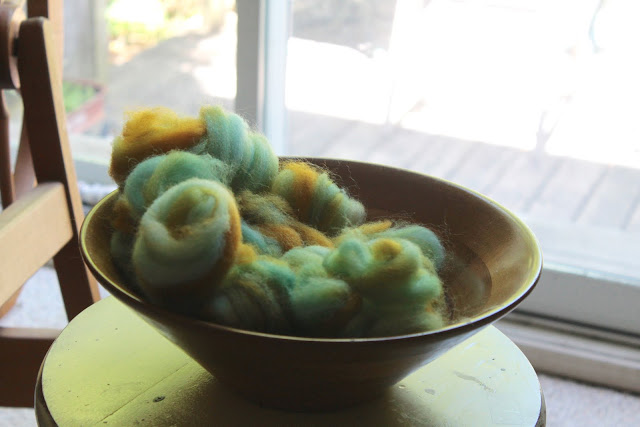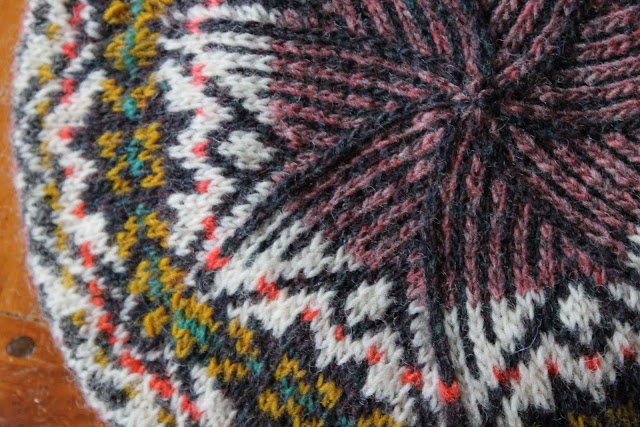Heidegger, Metaphysics, and Spindle Whorls
There is a love for tools which most knitters will admit. Certain tools just allow us to do our work better, faster, or to experience the process more pleasurably. We could each probably list our essential tool kit, as some bloggers have beautifully done (See Fringe Association’s series Our Tools, Ourselves). I was reading a collection of works by Martin Heidegger for a class paper/ pleasure, when I came across an excellent explanation of why tools (or "equipment," as the word is translated in this edition) are so important in our ability to created finished objects, but also validated in themselves as an intermediary. I never thought that I would read such a succinct and beautiful explanation of my love for creative tools in a text on metaphysics, but here it is:
 |
| I collect all types of needles: wood, metal, plastic. I love having them, even though I almost exclusively use circulars. |
“A piece of equipment, a pair of shoes for instance, when finished, is also self-contained like the mere thing, but it does not have the character of having taken shape by itself, like the granite boulder. On the other hand, equipment displays an affinity with the art work insofar as it is something produced by the human hand. However, by its self-sufficient presence the work of art is similar rather to the mere thing which has taken shape by itself and is self-contained. Nevertheless we do not count such works among mere things. As a rule it is the use-objects around us that are the nearest and authentic things. Thus the piece of equipment is half thing, because characterized by thingliness, and yet it is something more; at the same time it is half art work and yet something less, because lacking the self-sufficiency of the art work. Equipment has a peculiar position intermediate between thing and work, assuming that such a calculated ordering of them is permissible.” (Poetry, Language, Thought. 2013 edition. pg 28)
 |
| All my retro needles get stored in milk glass vases, and put where the sun can filter through them. |
There is a familiarity which grows from our tools. They are partially art, partially not. Usually they are not the end goal, but a tool in which to get there. Unless of course you are dedicated to making beautiful tools as well. My Twig&Horn ruler is beautiful, and I defy you to say these spindles are not art all on their own. Maybe your drug is walking into a stationary store and sniffing crisp paper.
 |
| My Twig & Horn Gauge ruler is a thing of beauty and function. Art, and yet not art, at the same time. |
And yet, as Heidegger continues a few pages, later, it is our use of tools (even those which are artistic in and of themselves) which distinguishes them from the final finished products. We don’t stop using our tools just because they are beautiful. In fact, we often use them more, as an knitter who has altered a pattern to use his or her favourite needles can attest. Tools are culturally significant, but we don't shield them or lock them away in vaults for their safety.
“A single piece of equipment is worn out and used up; but at the same time the use itself also falls away into disuse, wears away, and becomes usual. Thus, equipment wastes away, sinks into mere stuff. In such wasting, reliability vanishes. This dwindling, however, to which use-things owe their boringly obtrusive usualness, is only one more testimony to the original nature of equipmental being.” ( from Poetry, Language, Thought. 2013 edition. Pg 34)
 |
| These Milward's were produced in the early 20th Century, and nickel plated to avoid rusting. They have stood the test of time. |
Herein lies the beauty of old, worn out tools. Even though they are no longer useful, their decay reminds us of the fact that they once fully participated in the the movement of matter through form to the final artistic definition. I distinctly remember the day my mother, in her infinite wisdom, told me that her definition of beauty was an old wooden spoon, because she was always reminded of its faithfulness to the baker. It was beautiful because it fulfilled its intended purpose. The beauty of functionality. It's why we speak lovingly of wispy white hair and laughter lines; the same wear and tear applies to humans as well.
I think this is why I love old spindle whorls so much. I run through each archeology museum I visit in search of whorls and loom weights. They are usually stone, and in many cases, they have survived the objects that they helped to create. Their functional beauty has left me in tears sometimes, feeling a sense of gratitude towards these inanimate objects, that they allowed women and men of the past to make the things they need to survive.
 |
| Whorls on spindles, Nationalmuseet, Copenhagen. Photographed in 2014. |
 |
| Chinese Neolithic, Royal Ontario Museum, Toronto. Photographed 2016 |
Those are pictures I have taken of whorls from two very diverse cultures, China and Denmark. Spindle whorls are a great social leveller, defying categorization as strictly European or for use by upper class women. For thousands of years there were no advancements in technology for spinning wool, so humans everywhere, no matter their race or class, need a spindle whorl. Men spun, women spun, children spun while walking along to school. Wool for fine cloaks and wool for rustic cloaks were spun using the same methods (albeit different materials). That is why I love these weird little rocks. Thanks, Heidegger, for putting that feeling into words.


Craziness! As I was reading this I was thinking about people and then got to the point where you mentioned my spoon. I love you!
ReplyDelete